Menus
- Travel enduros, athletes and all-rounders put to the test in the Alps
- Criteria that are important in terms of driving dynamics are tested
- Five groups, two defending champions and a final
- The test round
- Travel enduros
- Cramped posture on the Ducati Hyperstrada
- Aprilia Caponord amazingly effortless
- KTM 1190 Adventure R is hard to hold
- Data and measured values
- Alpen Masters ranking
- 1st place: KTM 1190 Adventure R
- 2nd place: Aprilia Caponord 1200 ABS Travel Pack
- 3rd place: BMW F 800 GS Adventure
- 4th place: Ducati Hyperstrada
- All-rounder
- Kawasaki Z 800 with slightly delayed performance
- Easy group win for Triumph Street Triple R.
- Data and measured values
- Alpen Masters ranking
- 1st place: Triumph Street Triple R
- 2nd place: Kawasaki Z 800
- 2nd place: MV Agusta Brutale 1090 ABS
- 4th place: Honda CB 1100
- athlete
- Involuntary freestyle deposits with the Triumph Daytona
- With the BMW HP4, even leisurely twitching is fun
- Data and measured values
- Alpen Masters ranking
- 1st place: BMW HP4
- 2nd place: Kawasaki ZX-6R 636
- 3rd place: Triumph Daytona 675
- 4th place: Aprilia RSV4 R APRC ABS
- This is how MOTORRAD tests
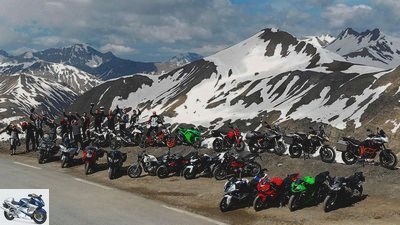
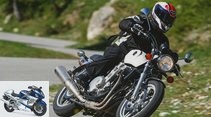
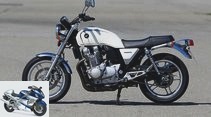
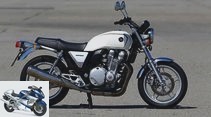
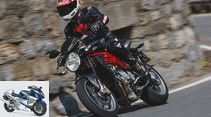
116 photos
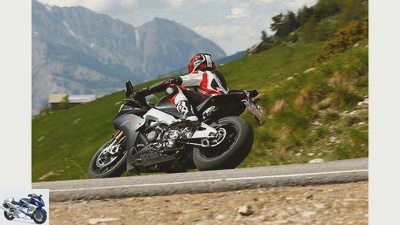
fact,
1/116
The extreme seating position was also not ideal for the test track.
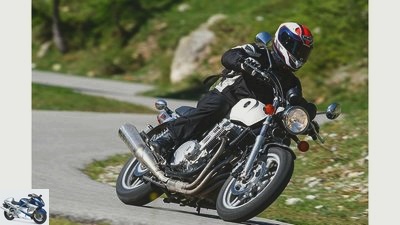
fact,
2/116
However, the Honda offers enough space for a passenger.
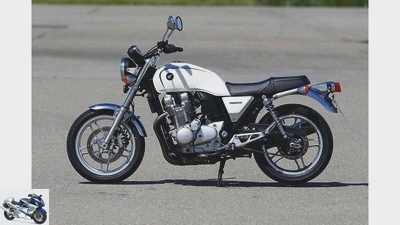
fact,
3/116
The Honda has a cultivated running engine, the suspension elements are too undemanding for a total price of 10,990 euros.
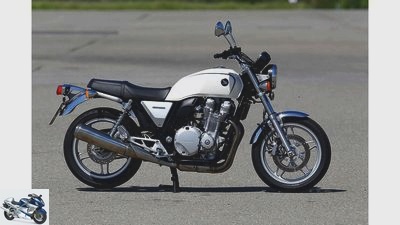
fact,
4/116
The Honda CB 1100 came in last.

fact,
5/116
However, the MV Agusta is not for the small budget, because the price of 13,590 euros is extremely high compared to the competition.
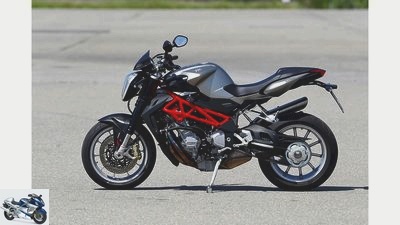
fact,
6/116
The MV Agusta has an absolutely powerful engine.
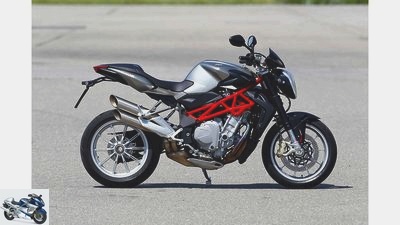
fact,
7/116
The MV Agusta Brutale 1090 ABS was able to achieve the same number of points as the Kawa.
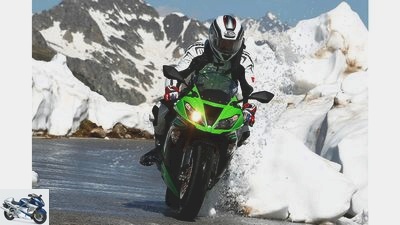
fact,
8/116
However, the ninja often starts with a delay.
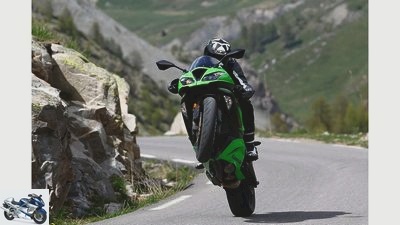
fact,
9/116
The Kawa can also convince with its gentle throttle response.
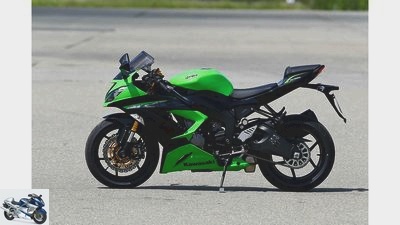
fact,
10/116
The Kawasaki offered tolerable seating comfort on the test track.

fact,
11/116
Second place went to the Kawasaki ZX-6R 636.

fact,
12/116
However, their outward appearance is convincing due to the careful workmanship with high-quality components.

fact,
13/116
It also has a low weight and a long range.
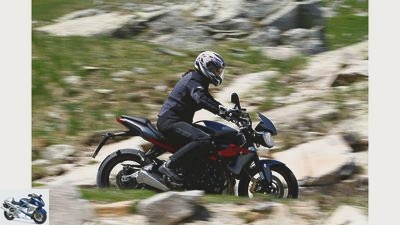
fact,
14/116
The Street Triple is particularly impressive thanks to its good coordination of engine and chassis.
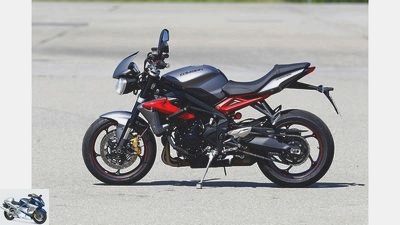
fact,
15/116
With its lightness, the Triumph transforms even the most delicate hairpin bends into a lively course.
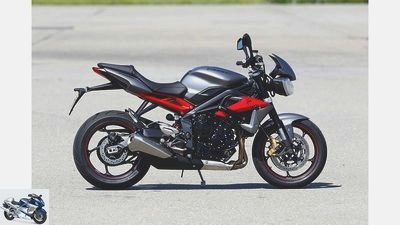
fact,
16/116
First place in the all-rounder comparison went to the Triumph Street Triple R..
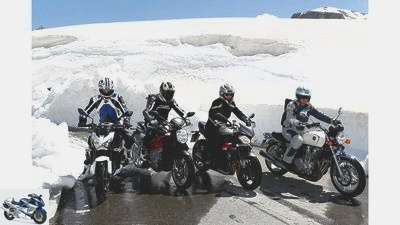
fact,
17/116
A direct comparison showed which models were particularly convincing.

fact,
18/116
The four models were also not affected by the weather.

fact,
19/116
With luggage and a passenger in tow, the Honda CB 1100 touches down very early.
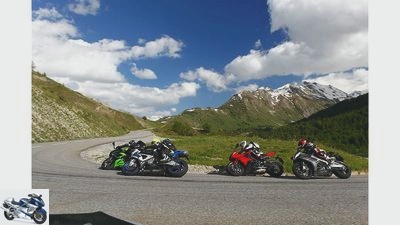
fact,
20/116
The athlete category was also carefully scrutinized
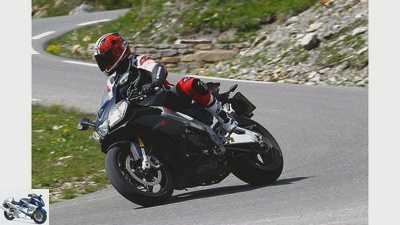
fact,
21/116
The fuel consumption of the Aprilia is not without it.
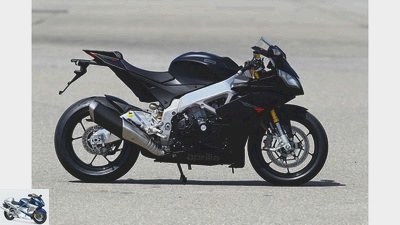
fact,
22/116
The Italian’s suspension has excellent feedback.
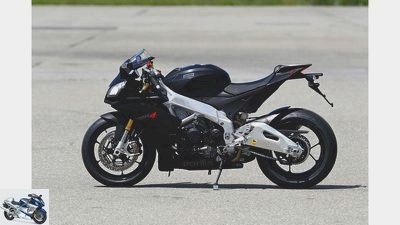
fact,
23/116
The Aprilia RSV4 R APRC ABS came in last.
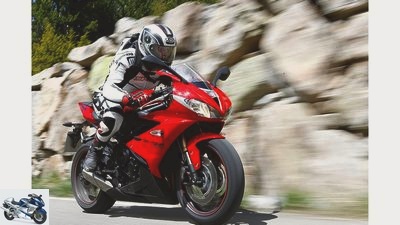
fact,
24/116
However, the steady development of strength convinced the Alps.
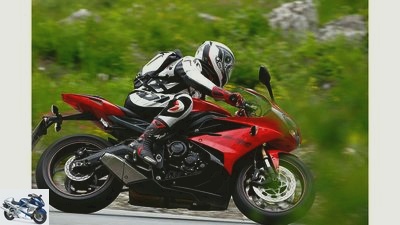
fact,
25/116
However, the rear suspension of the Triumph is a bit stubborn.
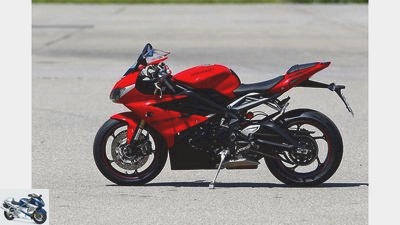
fact,
26/116
The Daytonba offers both good driving performance and good handling.
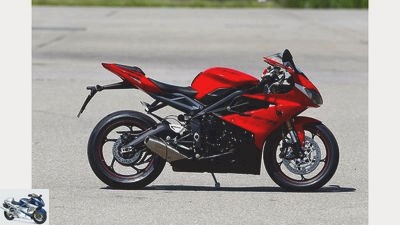
fact,
27/116
Third place went to the Triumph Daytona 675.
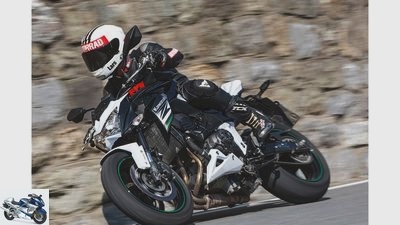
fact,
28/116
Since it was a tough battle among the competitors, the Kawasaki shares second place with the MV Agusta.
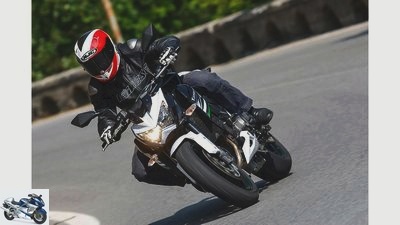
fact,
29/116
In addition, the Kawa has good acceleration and torque values.
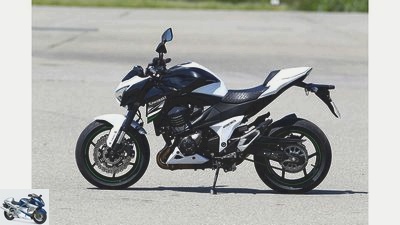
fact,
30/116
The Kawasaki offers a firm, fully adjustable chassis.
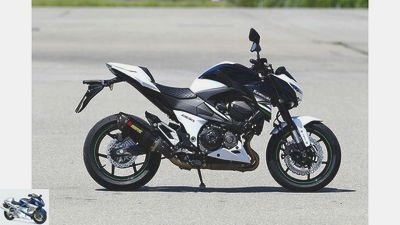
fact,
31/116
The Kawasaki Z 800 landed in second place.
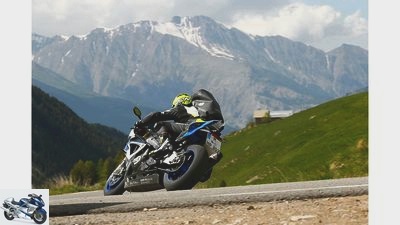
fact,
32/116
In addition, the Bavarian offers very good stability.
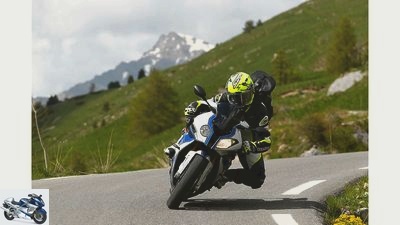
fact,
33/116
The brakes on the BMW HP4 in particular are phenomenal.
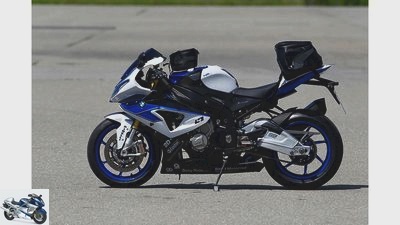
fact,
34/116
The Alps are not the best place to test athletes, but the Bavarian is also the Oberhammer in this environment.
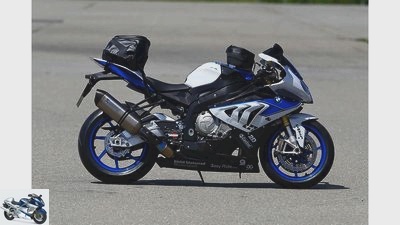
fact,
35/116
The BMW HP4 took first place among the athletes.
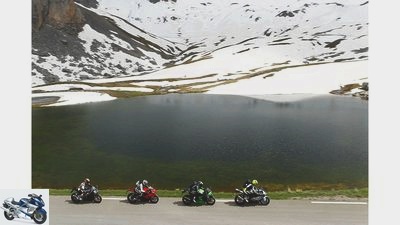
fact,
36/116
The models from BMW, Kawasaki, Triumph and Aprilia were tested.
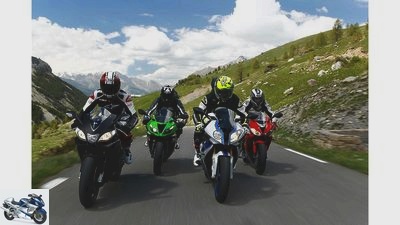
fact,
37/116
Because of the difficulty of the route, this turned out to be a tingling experience.
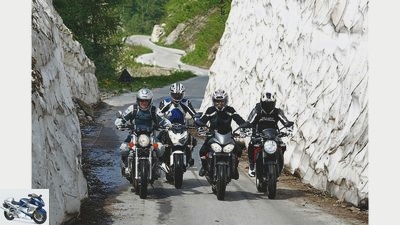
fact,
38/116
The all-rounders mastered the Alps brilliantly.
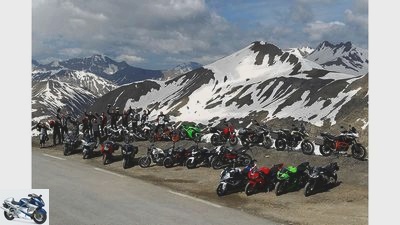
fact,
39/116
The Alpen-Masters is the biggest MOTORCYCLE group test of the year.

fact,
40/116
Models from the manufacturers Aprilia, BMW, Ducati and KTM were tested.
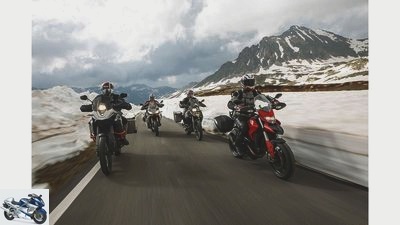
fact,
41/116
First, the travel enduros were tested.

fact,
42/116
Lars Bosson (49), surveyor in Gothenburg, two-time Swedish superbike champion. Started at the TT on the Isle of Man. Has been testing motorcycles for 24 years.

fact,
43/116
Francesco Gulinelli (36), mechanical engineer. Worked for frame manufacturer Verlicchi, suspension manufacturer Marzocchi and drives series sport races.
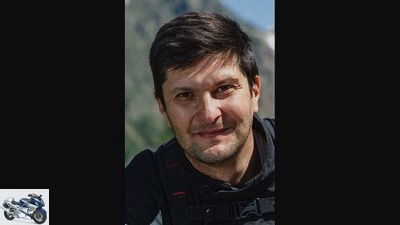
fact,
44/116
Kristijan Ticak (39), editor-in-chief. Tests cars, but loves motorcycles. Had to go into the Balkan War as a motorcycle reporter. Was at eight of nine Alpine Masters.
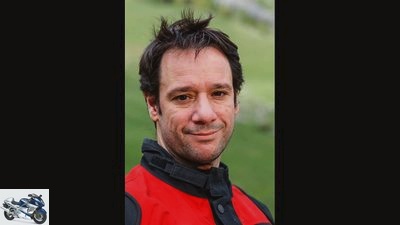
fact,
45/116
Oscar Pena (40), test editor. Contested the Spanish Supersport Championship. Wild on the racetrack, mild on the country road. It was the first time in my life in the Alps.

fact,
46/116
Gert Thole (57), test manager, inventor of the Alpine Masters. Whether in motocross, house renovation or at work – only the best counts.

fact,
47/116
Karsten Schwers (41), top tester. Knows everything, can do everything, plans everything and organizes everything – no problem at all.

fact,
48/116
Peter Mayer (53), test editor. Likes his country estate, the wide world – and drives everything that rolls on two wheels. With and without a motor.

fact,
49/116
Sven Loll (39), photo driver, dressman, bon vivant. Likes motorcycles, women, bathtubs, WiFi access – and its peace and quiet.

fact,
50/116
Rainer Froberg (49), fleet manager. Ensures a good mood, fully fueled motorbikes – and privately likes his Harley.

fact,
51/116
Eva Breutel (52), Italy correspondent. Loves Italian motorcycles, lives in Italy – and likes the French Alps.
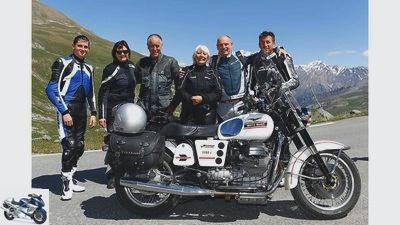
fact,
52/116
You can see part of our test crew.

fact,
53/116
In the first part of the Alpine Masters, travel enduros, all-rounders and athletes were tested.
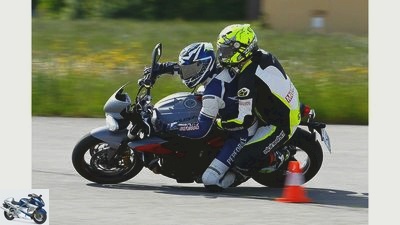
fact,
54/116
In the slalom and in the circular path, the limits of the bikes could be explored exactly and reproducibly.
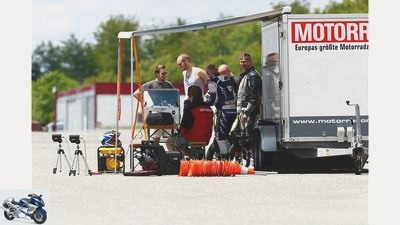
fact,
55/116
However, the motorcycles first had to show their colors on the test course.

fact,
56/116
The tour to the Alps started from Neuhausen near Stuttgart.
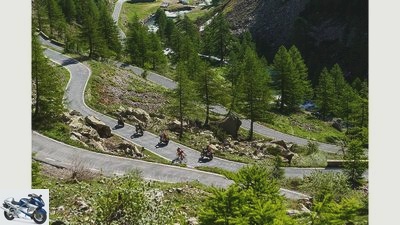
fact,
57/116
Full concentration was the order of the day on the winding route.
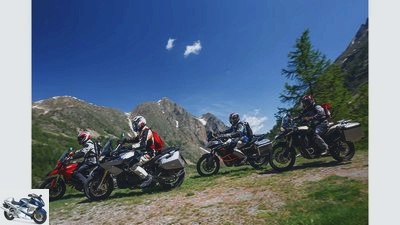
fact,
58/116
The two-wheeled all-rounders represent the lion’s share of all motorcycles in the mountains.
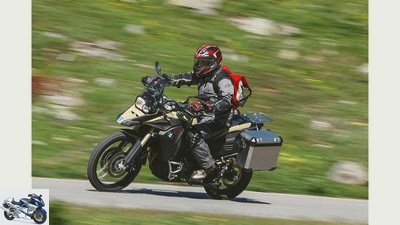
fact,
59/116
This is mainly due to its low fuel consumption and the enormous range that the BMW F 800 GS Adventure offers.
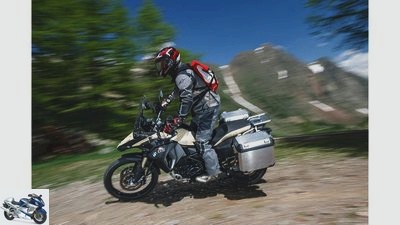
fact,
60/116
However, these strengths were not enough for the Bavarian to secure the Alpine throne.
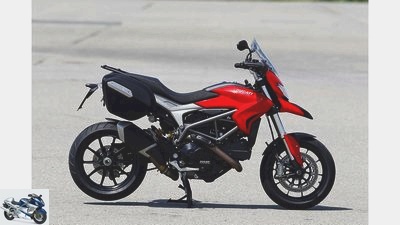
fact,
61/116
Last place went to the Ducati Hyperstrada.
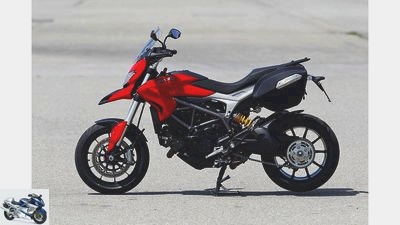
fact,
62/116
Although the Ducati shines with its sportiness, it is only suitable for travel to a limited extent.
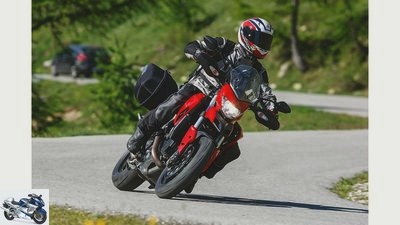
fact,
63/116
The Ducati Hyperstrada, for example, hardly offers any wind protection.
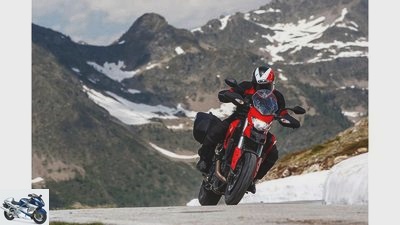
fact,
64/116
However, the fuel consumption is very low and the handling is extremely agile.
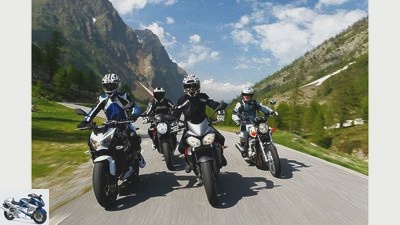
fact,
65/116
In addition, four all-rounders were tested.
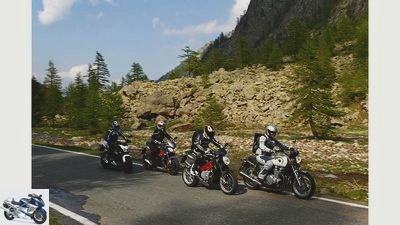
fact,
66/116
These included models from Honda, Kawasaki, MV Agusta and Triumph.
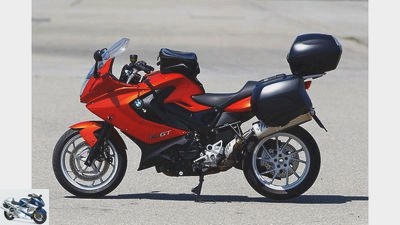
fact,
67/116
Above all, the BMW F 800 GS offers high travel quality.
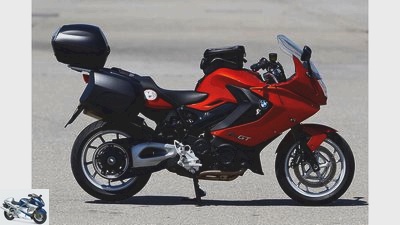
fact,
68/116
The BMW F 800 GS Adventure landed in third place.
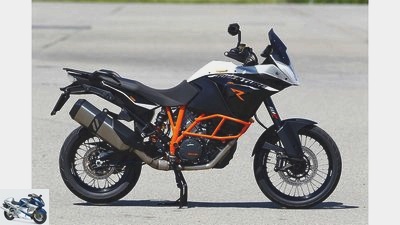
fact,
69/116
The KTM 1190 Adventure R took first place in the travel enduro comparison test.

fact,
70/116
The KTM Adventure was particularly convincing with its very lively and powerful engine.
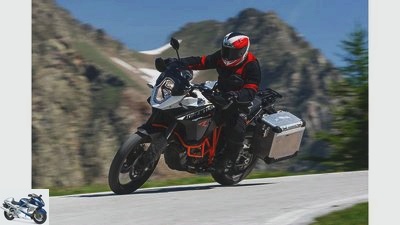
fact,
71/116
Compared to the competition, KTM was able to prevail in almost all criteria and also offers the most homogeneous overall package.
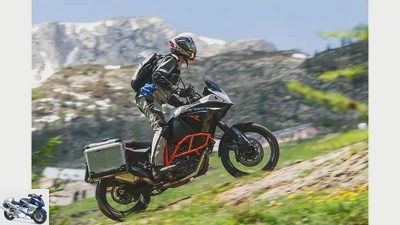
fact,
72/116
It is therefore not surprising that it is way ahead of the competition with almost 400 out of 500 points.
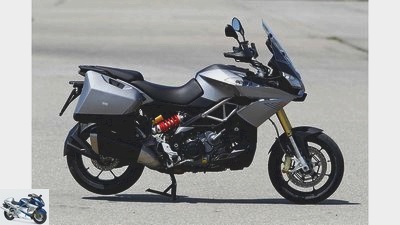
fact,
73/116
The Aprilia Caponord 1200 ABS Travel Pack took second place.

fact,
74/116
The Aprilia offers a sophisticated engine and comfortable suspension setup.

fact,
75/116
Comfort is the Italian’s strength.
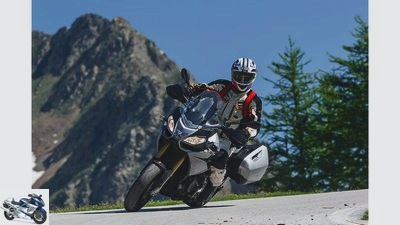
fact,
76/116
The handling of the Aprilia Caponord also leaves nothing to be desired despite its weight.
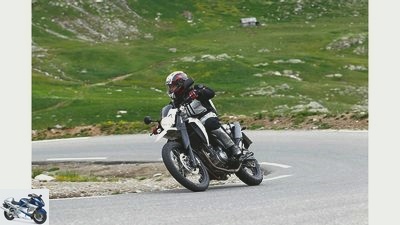
77/116
Even bumpy stretches are easy to cope with thanks to the long suspension travel.
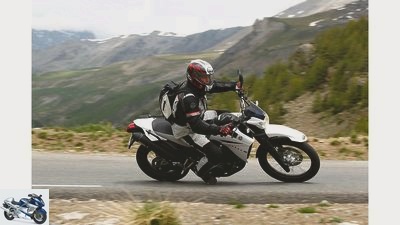
78/116
The Yamaha seems effortless and pleasant in the mountains.

79/116
Second place in the 48 hp bike comparison went to the Yamaha XT 660 R..

80/116
Although the bikes have little power compared to the other classes, the four models did extremely well despite everything.
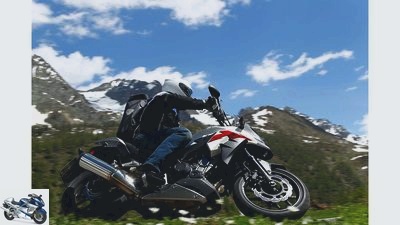
81/116
The Honda also offers well-regulated ABS and grippy brakes.
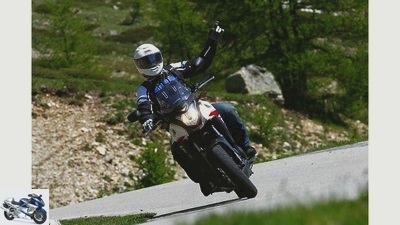
82/116
It impresses with its perfect handling in the mountains.

83/116
The Honda CB 500 X is an adult motorcycle for the small budget.
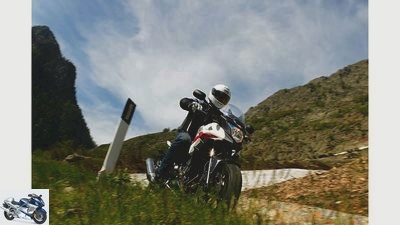
84/116
The Honda CB 500 X took first place and was allowed to take part in the final.

85/116
In a comparative test of the 48 hp bikes, the models from the manufacturers Honda, Kawasaki, KTM and Yamaha competed against each other.
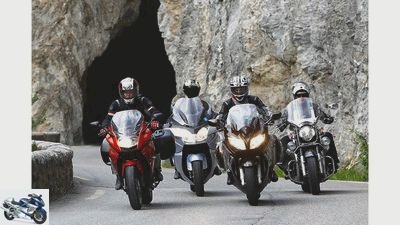
86/116
Despite their weight, the four tourers fought bravely.
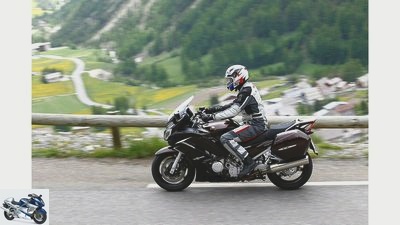
87/116
The handling of the Yamaha proved to be only moderate in the mountains.
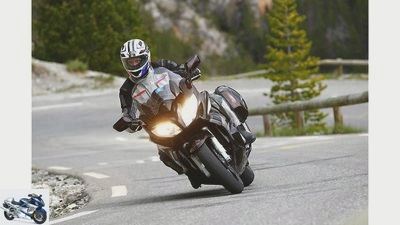
88/116
Third place went to the Yamaha FJR 1300 A..
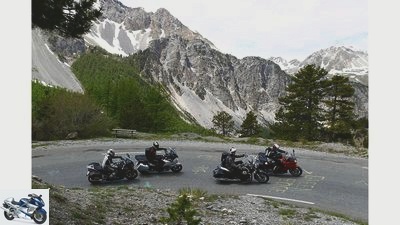
89/116
The narrow and winding roads were not necessarily easy to master with the tourers.
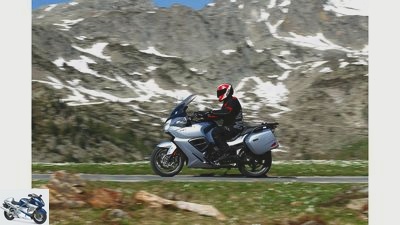
90/116
With an impressive weight of 303 kg, it is still agile in handling.
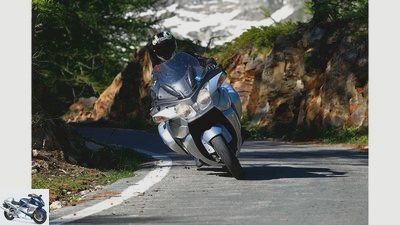
91/116
The Triumph Trophy SE landed in second place.
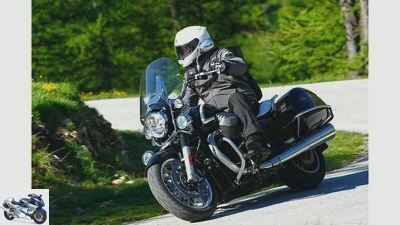
92/116
Last place went to the Moto Guzzi California Touring.
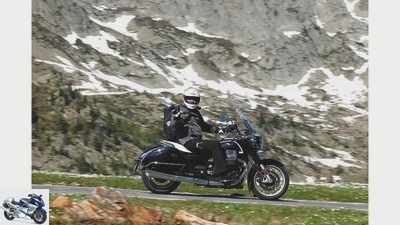
93/116
The Moto Guzzi was the heaviest in the lap at 345 kilograms and had to struggle with its heavy weight.

94/116
You give the tourers and yourself a break.
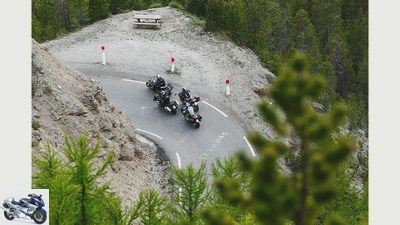
95/116
However, full concentration was required on the winding routes.
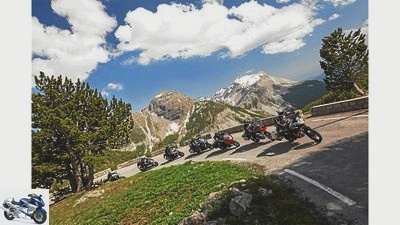
www.
96/116
The BMW F 800 GT, BMW HP4, BMW R 1200 GS, Honda CB 500 X, KTM 1190 Adventure R, Triumph Tiger Explorer and Triumph Street Triple made it into the final.
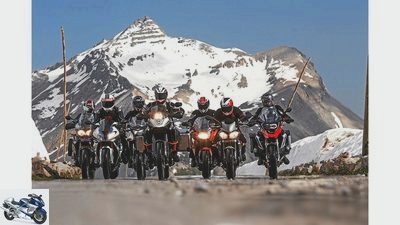
www.
97/116
With three Bavarian women in the race, the result of the big comparison was not strange.
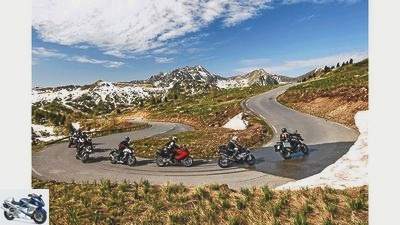
www.
98/116
The BMW HP4 took last place. Heating through the Alps with an athlete is not without it either.

www.
99/116
5th place was shared between the Triumph Street Triple R and the Honda CB 500 X. The BMW F 800 GT landed in 4th place. Third place went to the Triumph Tiger Exporer. The KTM 1190 Adventure R came in second.
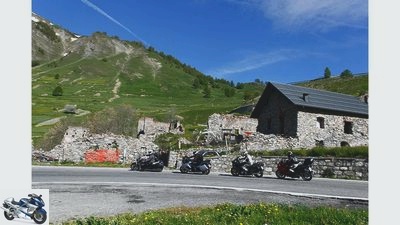
www.
100/116
A couple of heavy hums snaked through the mountains.
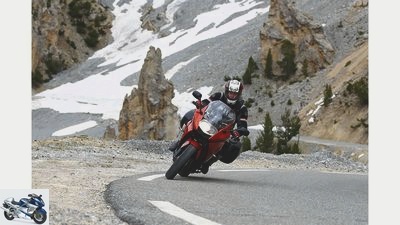
101/116
The BMW F 800 GT impressed above all with its excellent handling and extremely neutral driving behavior.
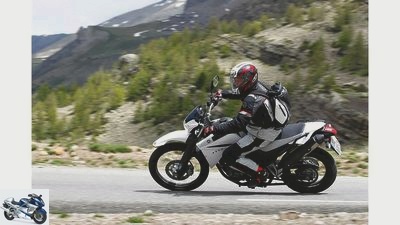
102/116
However, the Yamaha does not have ABS.
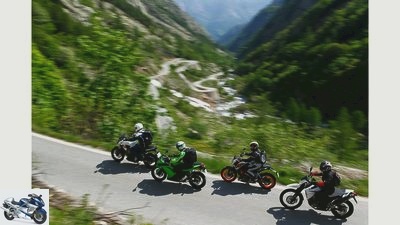
103/116
Some of the candidates didn’t even bring 48 hp, but even less.
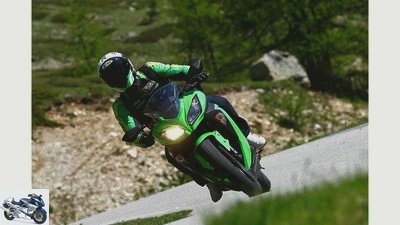
104/116
The Kawasaki Ninja 300 came in third.
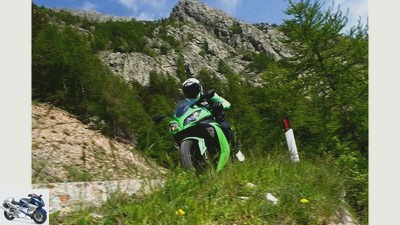
105/116
The Kawa convinces with its low fuel consumption.
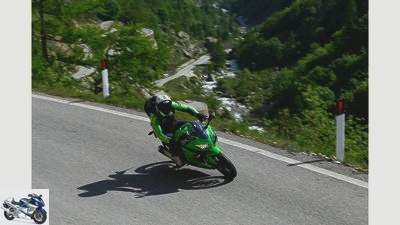
106/116
It also offers a lot of freedom of inclination when loaded.

107/116
However, there are wild orgies of turning and switching on steep passes.
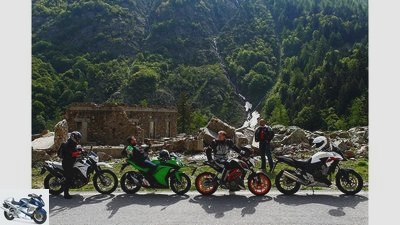
108/116
If breaks were the order of the day, then only intentionally and not because the machines no longer wanted to take part in the fun.

109/116
The KTM 390 Duke took last place.
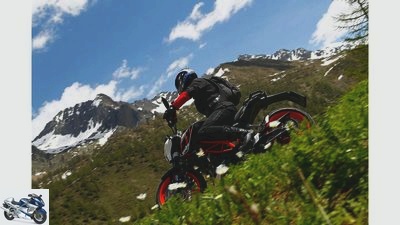
110/116
It couldn’t be more handy – the KTM is light, small and agile.
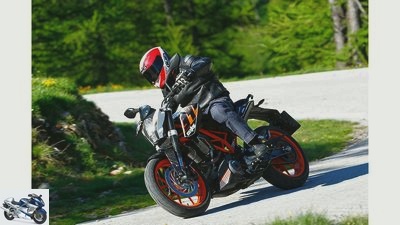
111/116
However, the suspension cannot convince.
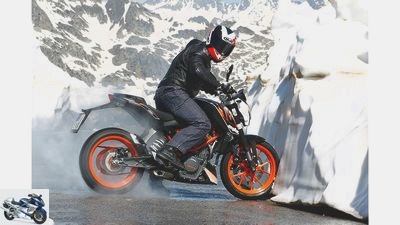
112/116
The journey also brought some pitfalls.
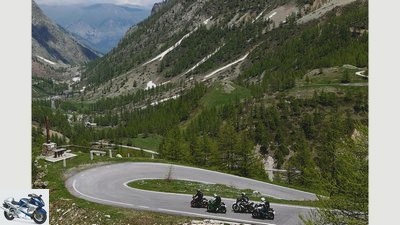
113/116
Downhill it is always easier for the 48 hp bikes.
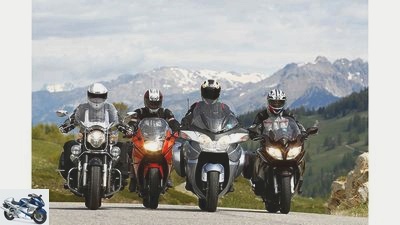
www.
114/116
In the tourer category, BMW, Moto Guzzi, Triumph and Yamaha competed against each other.

www.
115/116
The BMW F 800 GT landed in first place.
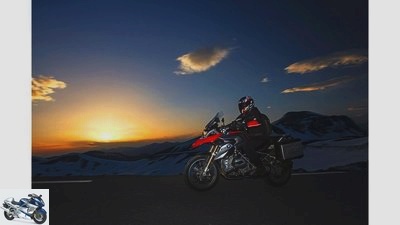
www.
116/116
The BMW R 1200 GS was the clear winner of the great 2013 Alpine Master.
Alpenmasters 2013 part 1
Travel enduros, athletes and all-rounders put to the test in the Alps
Where green meadows lined the slopes a year ago, the walls of snow piled meters high at this year’s Alpine Masters. Nevertheless: It has seldom been so much fun to see winter surrender at the biggest MOTORCYCLE test of the year.
S.Are we really right here? The approach to the top of the Col de la Lombarde is hardly recognizable. Exactly a year ago to the day, at the first edition of the Alpine Masters in this French-Italian border region, lush green still dominated the flat slopes of this pass. And now? Everything white. Only the day before, the clearance vehicles had cut a corridor into the snowy landscape. Now the asphalt strip meanders like a bobsleigh run between sometimes meter-high walls of snow up to the 2350 meter high pass. Exactly in time to add the last missing section to the test round of this year’s Alpine Masters – even if loose rubble, greasy clay and meltwater streams flowing over the road force you to cautiously slalom during the motorized summit storm.
Buy complete article

Alpenmasters 2013 part 1
Travel enduros, athletes and all-rounders put to the test in the Alps
Criteria that are important in terms of driving dynamics are tested
Nevertheless, it is also the extremes that make motorcycling in the mountains so attractive. Because like this freshly paved road, the impressions in the motorcycle saddle seem to be channeling into the mountains. Nowhere else do the road surfaces change so abruptly, potholes require line changes at lightning speed or force tight bends to carefully play with the accelerator and clutch. So what counts between the peaks are the essential qualities of a motorcycle.
www.
Our MOTORCYCLE test crew.
MOTORRAD therefore deliberately reduced the rating at the Alpine Masters to the criteria that are important in terms of driving dynamics. Steering precision, handling, pulling power, load change behavior or the righting moment when braking are becoming increasingly important. Less relevant aspects such as top speed, guarantee or maintenance costs are not taken into account.
The mode of hosting the Alpine Masters remains unchanged. For the most important new releases of 2013, a total of five, as homogeneous as possible, groups of four machines each are formed, which are evaluated in a preliminary round by the MOTORRAD test crew according to a points scheme. The respective winner moves on to the final.
No more bean counting there. Experienced testers from MOTORRAD’s international sister and partner magazines create a very personal ranking after a test round that has been significantly expanded compared to the qualification. The counting of the vote of this jury ultimately selects the winner of the Alpine Masters.

motorcycles
Alpenmasters 2013: 48 HP motorcycles
48 HP bikes in comparison at the 2013 Alpenmasters
read more
BILLION
The winners of the last few years.
However, the carefree serpentine slalom – usually a domain of fun or naked bikes freed from the ballast of everyday suitability – is not the only thing that determines the mountain king. In this final rating, too, the aspects of real life count, such as the qualities on arrival and departure, luggage storage or ease of maintenance on the tour. It is understandable that the Alpine champions of recent years are increasingly recruiting from the circle of travel enduros. Because whether on expressways or on the alpine mountain and valley railways, these concepts shine with impressive universality – and recently with rapid technical advancement.
One of the reasons why, for the first time in the history of the MOTORRAD Alpine Masters last year, the Triumph Tiger Explorer and the BMW R 1200 GS shared the winner’s trophy at the Col de la Bonette. A dominance which, by the way, reflects the situation on the mountain pass roads. The lion’s share of the alpine travel company actually swings their way up the switchbacks on the all-round talents.
Nonetheless, there are other ways to develop fun potential in the Alps. Namely on super athletes – with the appropriate attitude. And on all-rounders, the agile all-rounders. Curtain up for the first part of the MOTORRAD Alpine Masters 2013! In part 1, travel enduros, all-rounders and athletes are tested.
Five groups, two defending champions and a final
Impressive. 19 of the 20 machines in the five groups of the 2013 Alpine Masters have been heavily revised or redesigned for the current model year.
BILLION
Hohenrausch: With three very different passes, the test lap over 160 kilometers reflects all facets of alpine challenges.
The only exception: the Yamaha XT 660 R, which was revised for the last time in 2007, which in the 48 hp group as an enduro rounds off the range from athletes to fun bikes to all-rounders. It is obvious that no machine from this entry-level category can challenge the reigning mountain queens.
Even athletes usually have a difficult time on the mountain roads and generally have no chance in the fight for the throne. Nevertheless, especially under the extreme conditions in the mountains, the differences within the respective groups become much clearer. Strengths and weaknesses reveal themselves much more dramatically than in everyday life and paint a much sharper picture of each machine than would be possible under more moderate conditions. Which ultimately means nothing else than: Behind every Alpine King there are five princes who have matured within the framework of their respective concept.
The test round
Little traffic, grippy asphalt and the concentration of many long pass ascents and descents make the area in the French-Italian border region a good choice for motorcycle vacationers – and for the MOTORRAD Alpen-Masters.
Werel
The test track in the Franco-Italian border area.
The approximately 160-kilometer test circuit offers almost all facets of alpine road construction. As a starting point, the MOTORRAD crew with Pietraporzio (hotel tip: www.reginadelle alpi.com) chose the section of the loop in Italy. In fact, the first pass, the hardly used, 21-kilometer-long Col de la Lombarde with its winding eastern ramp and the extensive western side, is an insider tip among alpinists.
And it’s just a foretaste of the highlight of the round, the impressive 25-kilometer ascent to the Col de la Bonette. After the descent to Jausiers, the fast turns of the Col de Larche complete the route portfolio before the 17 hairpin bends leading back into the Stura valley end the curve slalom after the top of the pass.
It continues on the next pages with the tests of the travel enduro, all-rounder and athlete categories:
Travel enduros




21st photos
Pictures: Alpenmasters 2013 part 1
To home page
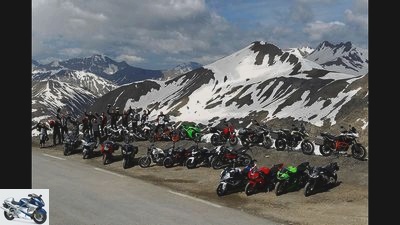
fact,

fact,

fact,
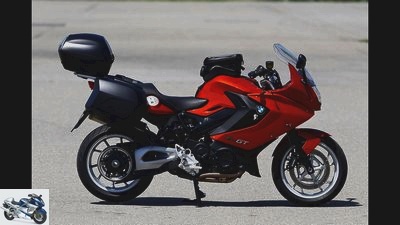
fact,
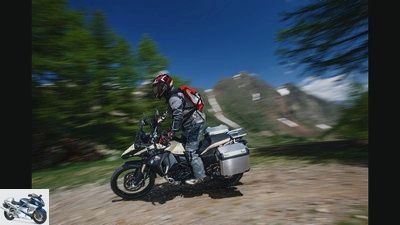
fact,
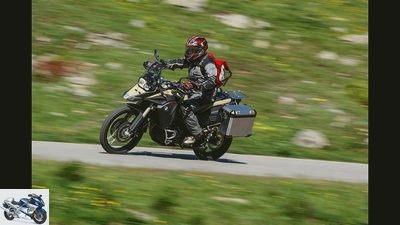
fact,
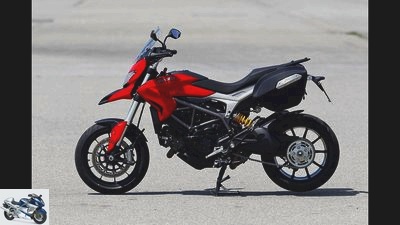
fact,

fact,
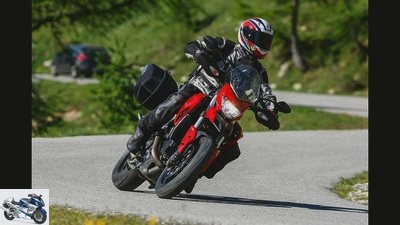
fact,
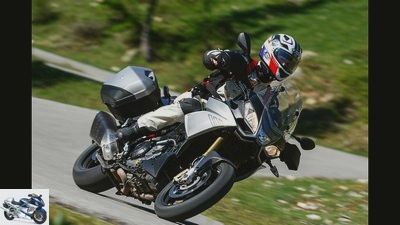
fact,
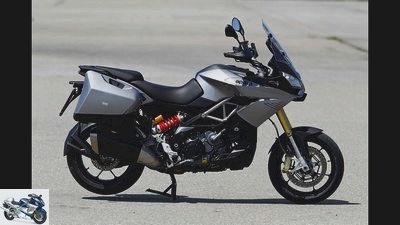
fact,
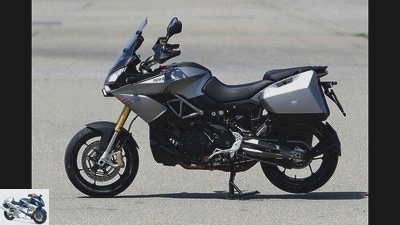
fact,
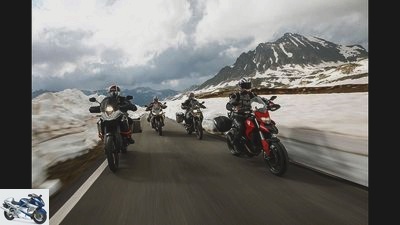
fact,
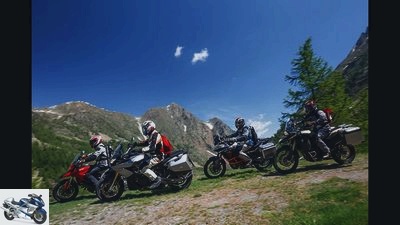
fact,
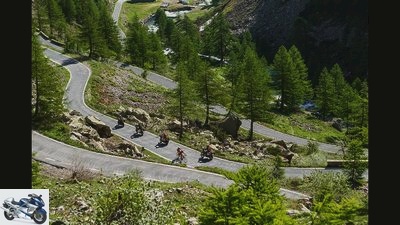
fact,
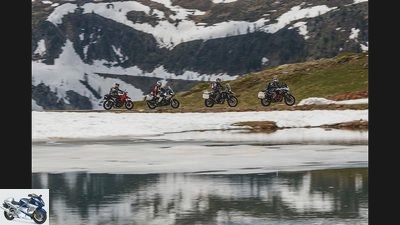
fact,
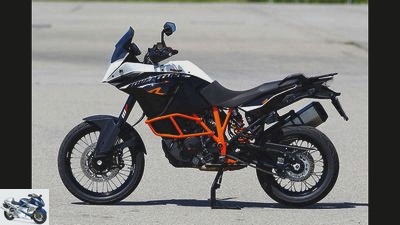
fact,

fact,
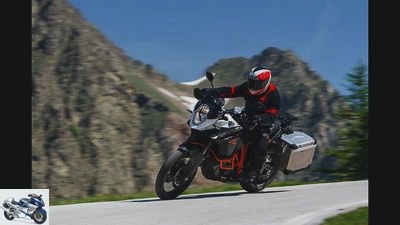
fact,
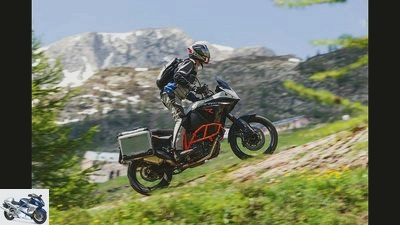
fact,
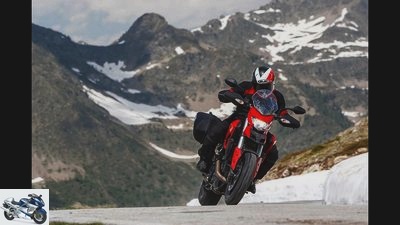
fact,
R 1200 GS and Tiger Explorer are waiting for the finalists
You can literally feel how comfortable the travel enduro quartet feels here. Understandable, as one is to a certain extent among his own kind. Whether on the rocky ridge of the Col de Lombarde, the sharp 170-degree bend at the Col de la Bonette or the flat top of the Col de Larche – the population of multifunctional adventure bikes in the mountains seems to be just as dense as that of marmots . The BMW GS models seem to be even more numerous than the whistling rodents. The Bavarian boxers dominate the mountain pass roads numerically – and the R 1200 GS also the Alpine Masters before the end of the year. That is why the woman from Munich, who shared the victory at the 2012 MOTORRAD Mountain Festival with the Triumph Tiger Explorer, is not waiting for the challengers until the final. After the model change that was carried out in winter, the current, water-cooled 2013 version of the GS replaces its predecessor.
The Ducati Hyperstrada is making its demands here in the Alps in a cheeky, fresh and unconventional way. After all, the Italian only differentiates between a higher windshield, softbags, a main stand, a softer shock absorber spring and a suspension travel on the fork that has been reduced by 20 millimeters from the Hypermotard fun bike. And in fact: When it comes to the sweeping Eckenwetz, the Duc is no fool. With a full tank of 207 kilograms, which is almost 40 kilograms less fat on her ribs than the rest of the group, the model athlete works nimbly in the tight bends and also keeps the line with the Pirelli Scorpion Trail tires much more precisely than her with the Pirelli Diablo Rosso II frosty, wobbly twin sister.
Cramped posture on the Ducati Hyperstrada
Since she lets her cultivated and lively 821-V2 catapult her onto the intermediate straights with great taste, she could indeed take the summit by storm. You read correctly: could. Because the sitting position, which is exaggeratedly close to the handlebars, forces a cramped posture, when braking the front sags even more than with the Hypermotard, and in passenger mode the low-lying main stand scrapes over the asphalt much too early. And that’s why the preppy Hyperstrada feels more comfortable under moderate conditions in an urban environment than on a climbing tour that is full of privation.
BILLION
The performance of the tested travel enduros.
In contrast to the BMW F 800 GS Adventure. With the tank enlarged to 24 liters, the Bavarian cannot be far enough away from the main routes. And so it crawls like a tireless Sherpa through the alpine relief, modest – like the Hyperstrada – even on the ascent and descent with just a little more than four liters of consumption and also wraps the ascetic ride with comfortable suspension, great seating comfort and good wind protection a feel-good pack.
However: With a total weight of over five hundred pounds of the Adventure (fully fueled 241 kilos plus 14 kilos of suitcase), even the 88 hp co-driver struggles in the steep bends, making the basic version of the F 800 GS, which is quite lively in the adventure outfit, appear strained. And because the additional fuel supply also nibbles a little on the previously so nimble handling and the fork and shock absorber pump each other with the crowd through their long spring travel on the undulating mountain roads, the strengths of the upgraded Baby GS are less in nimble passing swings than in long-distance travel.
Aprilia Caponord amazingly effortless
A terrain that the brand new Caponord from Aprilia also focuses on. The dignified appearance and the pronounced seating comfort for driver and passenger alone give the Italian a fluffy, touring-like driving experience. No wonder that with this predisposition, it blossoms on the long turns of the Col de Larche, finds its line like clockwork and lets the domesticated 1200 V2, which comes from the Dorsoduro fun bike, push hard. The fact that the semi-active suspension also casually puts away some bad potholes fits this enjoyment-oriented approach. The lady from Veneto does well in the narrow streets. The Caponord can be turned into corners with amazing ease, swinging back and forth in alternating curves, and it brakes superbly.
www.
Through ice and snow with the tested travel enduros.
The sovereign calm is only disturbed by the erection moment of the Dunlop Qualifier 2 and the limited inclination freedom in two-person operation. Or electronics. Because the obviously rich mixture setting, which gives it the highest fuel consumption of the quartet (6.1 liters / 100 km), slowed the Caponord in the thin air on the summit of the Bonette.
Like the Hyperstrada, the Aprilia could only be brought back to life by pushing it. To save her honor: Shortly before, the warning lamp in the cockpit had signaled disorientation in the engine management. But Aprilia dealers are not the only ones who are few and far between on the Alpine peaks. Nevertheless, the Caponord proves: A comfort-oriented orientation and driving fun in a demanding environment do not necessarily have to be mutually exclusive.
KTM 1190 Adventure R is hard to hold
Driving fun, alpine environment – these are the keywords that make the KTM 1190 Adventure R hard to hold. Because, let’s cut it short, the off-road version of the basic adventure equipped with 21/18 inch wheels shows the assembled competition where the hammer is. If only because the throttle, clutch, gearshift and brakes hardly need more than a gentle stroke, the engine is direct, cultivated, lively and with measured 146 hp is also extremely strong on the gas and the suspension is sporty, but not too tight.
With every detail, the Austrian seems to document a real body tension. And only those who have a direct comparison with the basic version will notice that the high front, which is advantageous off-road, costs a bit of steering precision on the road, the wind protection for the journey is a bit tight or the rustic aluminum cases are a little closer to the slim contours the “R” could nestle – and still be convinced that only one of this quartet can make it to the top: the KTM.
Data and measured values
| Aprilia Caponord 1200 ABS Travel Pack |
BMW F 800 GS Adventure |
Ducati Hyperstrada |
KTM 1190 Adventure R |
|
| engine | Two-cylinder | Two-cylinder | Two-cylinder | Two-cylinder |
| Displacement | 1197 cc | 798 cc | 821 cc | 1195 cc |
| power | 125 hp | 85 hp | 110 hp | 150 hp |
| Torque | 115 Nm | 83 Nm | 89 Nm | 125 Nm |
| Weight* | 255 kg | 241 kg | 207 kg | 244 kg |
| Payload | 205 kg | 213 kg | 199 kg | 196 kg |
| price | € 15903 | 12050 € | 12,590 € | € 14,895 |
| Price test motorcycle | € 15903 | € 14880 ** | 12,590 € | 15,747 € *** |
| Test consumption passes | 6.1 l / 100 km / h | 4.4 l / 100 km / h | 4.2 l / 100 km / h | 5.5 l / 100 km / h |
| theoretical range passes | 395 km | 550 km | 383 km | 420 km |
| Passage in 2000 m above sea level, 50-100 km / h |
7.2 sec | 7.8 sec | 6.2 sec | 6.9 sec |
| Pulling uphill with pillion passenger, 2nd gear, 25-75 km / h |
7.0 sec | 6.4 sec | 4.9 sec | 4.2 sec |
| Braking distance downhill with pillion passenger, 75-25 km / h |
24.5 m | 26.9 m | 25.7 m | 25.3 m |
* without case
** 1incl. Comfort package (370 euros), Enduro package (370 euros), ESA (295 euros), additional headlights (325 euros),
LED indicators (100 euros), case set (705 euros), navigation device (665 euros)
*** including aluminum case set (852 euros)
Alpen Masters ranking
| Maximum score |
Aprilia Caponord 1200 ABS Travel Pack |
BMW F 800 GS Adventure |
Ducati Hyperstrada |
KTM 1190 Adventure R |
|
| engine | |||||
| Acceleration 0-140 km / h | 20th | 17th | 14th | 17th | 18th |
| Passage in 2000 m above sea level | 20th | 16 | 14th | 18th | 16 |
| Pulling through in 2nd gear uphill with a pillion passenger | 20th | 13 | 14th | 18th | 20th |
| Power delivery | 20th | 16 | 15th | 16 | 18th |
| Response / load change behavior | 20th | 11 | 14th | 15th | 17th |
| coupling | 20th | 14th | 13 | 17th | 19th |
| circuit | 20th | 15th | 13 | 17th | 17th |
| Gear ratio | 10 | 8th | 9 | 9 | 8th |
| total | 150 | 110 | 106 | 127 | 133 |
| Driving behavior | |||||
| Coordination / comfort | 20th | 12th | 14th | 12th | 16 |
| Suspension reserves when loading | 20th | 13 | 14th | 10 | 15th |
| Manageability on mountain passes | 20th | 16 | 13 | 17th | 15th |
| Stability in turns | 20th | 13 | 11 | 12th | 16 |
| Steering precision / feedback | 20th | 12th | 14th | 11 | 15th |
| Braking effect | 20th | 17th | 13 | 17th | 18th |
| Downhill braking / fading | 20th | 14th | 13 | 16 | 16 |
| SECTION | 15th | 11 | 13 | 14th | 14th |
| Traction control | 5 | 4th | 4th | 5 | 5 |
| Righting moment when braking | 10 | 8th | 8th | 7th | 8th |
| No inclination when loading | 10 | 5 | 5 | 3 | 7th |
| total | 180 | 125 | 122 | 124 | 145 |
| everyday life | |||||
| Furnishing | 20th | 14th | 14th | 8th | 16 |
| Luggage storage | 10 | 6th | 6th | 8th | 6th |
| Range passes | 20th | 18th | 20th | 17th | 20th |
| Payload | 20th | 13 | 15th | 12th | 11 |
| Loading handling | 10 | 4th | 4th | 7th | 4th |
| Front / rear view | 10 | 6th | 7th | 4th | 6th |
| Ground clearance with pillion passenger and luggage | 10 | 9 | 10 | 6th | 10 |
| total | 100 | 70 | 76 | 62 | 73 |
| Comfort | |||||
| Driver comfort | 20th | 17th | 15th | 9 | 16 |
| Seating comfort passenger | 20th | 15th | 15th | 11 | 13 |
| Wind and weather protection | 20th | 15th | 16 | 8th | 13 |
| Smooth running engine | 10 | 6th | 4th | 6th | 5 |
| total | 70 | 53 | 50 | 34 | 47 |
| Total | 500 | 358 | 354 | 347 | 398 |
| Placing group | 2. | 3. | 4th. | 1. |
Conclusion:
A remarkable performance: the KTM 1190 Adventure R is ahead of the competition in almost all criteria and also clearly offers the most homogeneous overall package. Individual strengths such as good comfort (Aprilia), travel qualities (BMW) or sportiness (Ducati) are not enough to claim the throne, especially in the Alps.
1st place: KTM 1190 Adventure R
www.
Could convince in a large comparison – the KTM 1190 Adventure R..
plus
- Engine very lively, powerful and yet easy to control
- excellent driving performance
- smooth-running fittings
- quality workmanship
- great coverage
minus
- Less handling than the basic version
- Suspension relatively tight
- thin seat pad
2nd place: Aprilia Caponord 1200 ABS Travel Pack
www.
Second place went to the Aprilia Caponord 1200 ABS Travel Pack.
plus
- sophisticated engine
- comfortable suspension-
- poll
- very good seating comfort
- Handling for this
- Weight class good
minus
- Weight relatively high
- high consumption
- Self-steering behavior on bumps
3rd place: BMW F 800 GS Adventure
www.
The BMW F 800 GS Adventure took third place.
plus
- low consumption
- enormous range
- very good wind protection
- Technology proven and stable
minus
- large seat height
- Handling suffers from a large rear tank
- Vibrations at higher speeds
4th place: Ducati Hyperstrada
www.
The Ducati Hyperstrada brought up the rear in direct comparison with the competition.
plus
- Engine cultivated and
- very tangy
- agile handling
- low consumption
- low weight
- low seat height
minus
- Sitting position that takes getting used to
- moderate wind protection
- limited travel suitability
All-rounder




21st photos
Pictures: Alpenmasters 2013 part 1
To home page

fact,
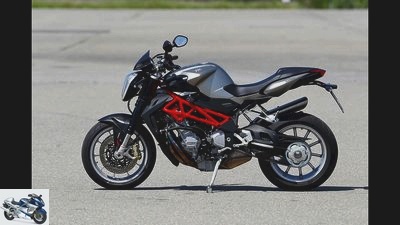
fact,
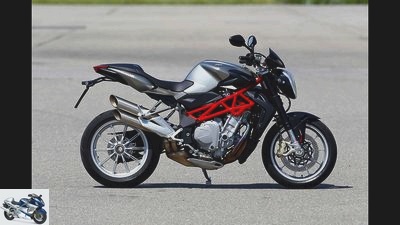
fact,
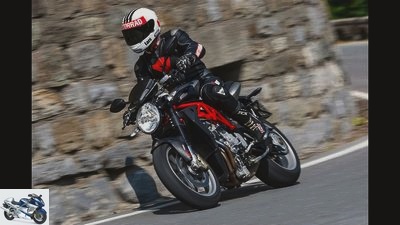
fact,
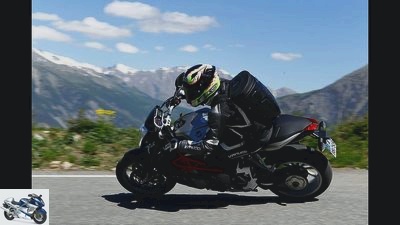
fact,
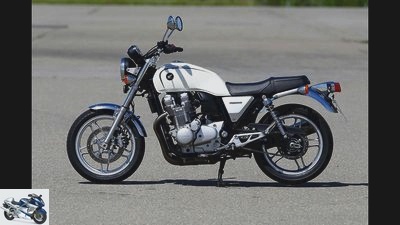
fact,
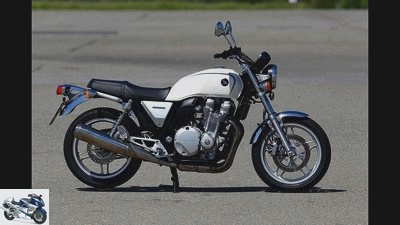
fact,
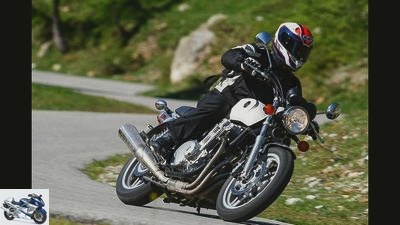
fact,
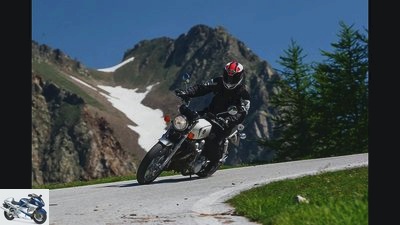
fact,
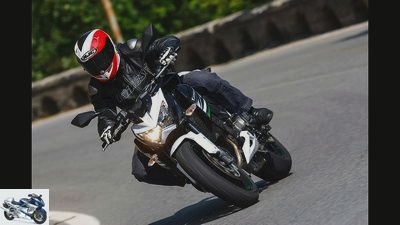
fact,
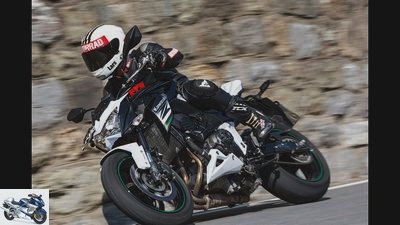
fact,
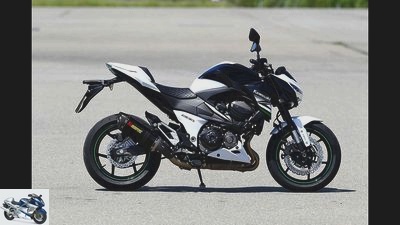
fact,
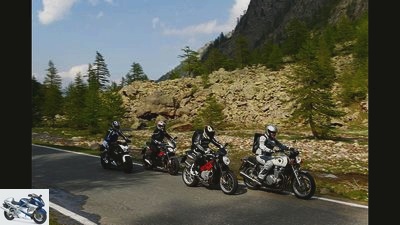
fact,

fact,
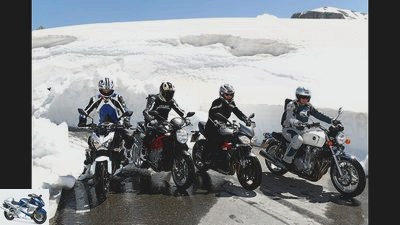
fact,
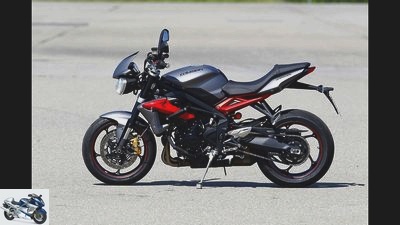
fact,
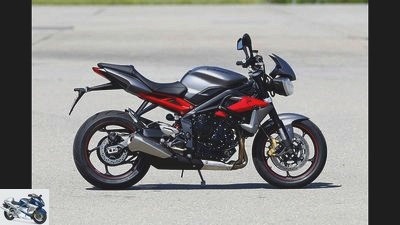
fact,
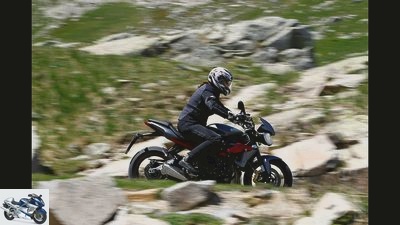
fact,
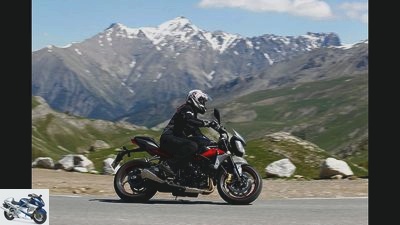
fact,
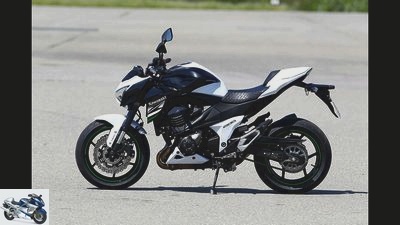
fact,
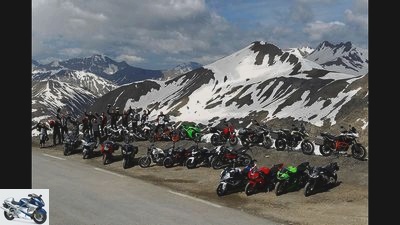
fact,
Honda CB 1100 in the pass carousel and endurance test
The Honda managers hesitated for a long time before bringing the classic CB 1100, originally developed for Japan, to Europe. And now that: As soon as the retro queen has acclimatized a little, she is already subjected to an endurance test in the demanding pass carousel of the Western Alps, her peaceful character has to face the dashing Kawasaki Z 800, the classy MV Brutale 1090 and the spirited Triumph Street Triple Claim R. It won’t go wrong in a minute?
Don’t worry, the CB 1100 does well in the high alpine regions. Despite her slight optical custom appeal and the highest weight in her group, she easily cleans up hairpin bends and curves, is easy to turn in and offers the most balanced seating position of the four competitors. This is the only place where the passenger can find a comfortable place, the luggage hooks are well thought out, and there is even a helmet lock – by the way the only thing we found at this year’s Alpen Masters. Honda currently only has one luggage rack in its range for the CB 1100, but the accessories trade provides suitcases, tank bags and top cases for good travel equipment. The four-cylinder engine with measured 92 hp grips gently but emphatically. Comfortable around the bottom, it revs up in the middle area, it gets rather tough upwards.
In order to accelerate from 50 to 100 km / h in the mountains, the Honda needs 9.2 seconds and is clearly lagging behind in a four-man comparison. In addition, there are the quite undemanding spring and damper elements and a limited freedom of inclination when loading, which is why it only reaches fourth place in the test field in the end.
BILLION
The performance of the all-rounders from MV Agusta, Kawasaki, Triumph and Honda.
The CB 1100 is by no means beaten. It is the right alpine partner for connoisseurs who don’t care about the last few seconds and millimeters.
The straight, wide handlebars and the compact appearance of the Kawasaki Z 800, on the other hand, scream for attack, underlined by the Akrapovic exhaust, which is available as an option. But the kawa is not as wild as it is. The 110 horsepower measured by the four-cylinder engine would certainly allow a hot ride over the mountain ridges, but then the relatively high weight of 231 kilograms soon becomes tiring. So it’s better to rush quickly, but not immediately over the pass heights. Then the tight spring elements, adjustable in rebound and preload, provide good road holding. The engine picks up robustly and is good in the juice from 3000 rpm.
Kawasaki Z 800 with slightly delayed performance
However, anyone who accelerates from pushing in tight bends, for example on the thread-thin windings of the Col de la Lombarde, can experience an unpleasant surprise, because the performance is occasionally slightly delayed. When measuring downhill brakes with a pillion passenger, the Kawasaki put down a heavy stoppie, but the seat that is too narrow at the back is hardly suitable for longer journeys with a passenger. As a travel accessory, Kawasaki only offers a windshield. All in all, the Z 800 can be willingly tamed and swiftly shooed across the Alps adventure playground. That’s enough for second place in the hotly contested all-rounder field.
www.
The all-rounders from Honda, Kawasaki, MV Agusra and Triumph in comparison.
Even the idiosyncratic MV Agusta Brutale 1090 makes it tied for points. Stubbornly, her four-cylinder with measured 144 hp only accelerates from 2000 rpm, below that nothing is going on. But then the engine ignites fireworks, which on the one hand require the greatest caution in tight bends, but on the other hand give the driver an incomparable, highly emotional roller coaster tumble. In this way, the MV manages the best pulling power of all motorcycles at the Alpine Masters, not even the athletes can keep up: with 5.1 seconds from 50 to 100 km / h, it is unmatched ahead.
Just as unfortunately with their consumption of 7.1 liters, plus the comparatively high price of 13590 euros. So it’s not all perfect sunshine. The look and workmanship are beyond any doubt, even the rubber covers of the rearview mirrors have been carefully styled. There are also full points for the lean angle with a load, and the chassis with the fully adjustable fork is generally a little soft, but of high quality. For luggage transport, MV Agusta offers various tank bags and nice rear and handlebar bags that hardly fit more than a credit card. After all, there are luggage hooks and a travel bag can be easily attached. In general, the Brutale 1090 in the Alps is a case in itself: extreme, radical, unsettling and inspiring at the same time.
Easy group win for Triumph Street Triple R.
The Triumph Street Triple R proves that a spirited performance does not have to be unconditional. Despite the smallest engine and the lowest torque of the four competitors, it easily wins the group. This is simply due to the harmonious interaction between their 106 hp three-cylinder and the chassis. No other in the field of all-rounders swings so easily around the curves and bends on passes, none is more handy and stable in curves, none gives more feedback, none stays more precisely on the line and none brakes more effectively. The lively 675 cm³ engine is always there when you need it, unobtrusive and yet powerful.
The Triumph diligently collects points, which result in a strong mix, because casual cruising in the mountains is just as much fun with it as the dedicated hunt to the next pass. So you did everything right at Triumph? Well, not quite: Without a luggage rack from the accessory trade, you can’t even strap a bag onto the motorcycle unless you wrap the straps around the indicator bracket, which is less advisable.
Data and measured values
| Honda CB 1100 |
Kawasaki Z 800 |
MV Agusta Brutal 1090 ABS |
Triumph Street Triple R |
|
| engine |
Four-cylinder | Four-cylinder | Four-cylinder | Four-cylinder |
| Displacement |
1141 cc | 806 cc | 1078 cc | 675 cc |
| power |
90 hp | 113 hp | 144 hp | 106 hp |
| Torque |
93 Nm | 83 Nm | 112 Nm | 68 Nm |
| Weight |
248 kg | 231 kg | 219 kg | 188 kg |
| Payload |
173 kg | 180 kg | 174 kg | 189 kg |
| price |
10990 € | € 9495 | 13590 € | 9090 € |
| Price test motorcycle |
10990 € | 10401 € * | 13590 € | 9090 € |
| Test consumption passes |
4.8 l / 100 km / h | 4.9 l / 100 km / h | 7.1 l / 100 km / h | 4.6 l / 100 km / h |
| theoretical range passes |
304 km | 345 km | 324 km | 377 km |
| Passage in 2000 m above sea level, 50-100 km / h |
9.2 sec | 6.6 sec | 5.1 sec | 6.5 sec |
| Pulling uphill with pillion passenger, 2nd gear, 25-75 km / h |
6.6 sec | 5.4 sec | 4.2 sec | 6.5 sec |
| Braking distance downhill with pillion passenger, 75-25 km / h |
24.9 m | 25.0 m | 30.0 m | 27.4 m |
* including Akrapovic exhaust (713 euros) and engine protection (193 euros)
Alpen Masters ranking
| Maximum score |
Honda CB 1100 |
Kawasaki Z 800 |
MV Agusta brutal 1090 ABS |
Triumph Street Triple R |
|
| engine | |||||
| Acceleration 0-140 km / h | 20th | 16 | 17th | 18th | 17th |
| Passage in 2000 m above sea level | 20th | 11 | 17th | 20th | 17th |
| Pulling through in 2nd gear uphill with a pillion passenger | 20th | 14th | 17th | 20th | 14th |
| Power delivery | 20th | 16 | 15th | 17th | 16 |
| Response / load change behavior | 20th | 18th | 14th | 11 | 15th |
| coupling | 20th | 14th | 13 | 13 | 14th |
| circuit | 20th | 13 | 13 | 12th | 12th |
| Gear ratio | 10 | 8th | 8th | 8th | 8th |
| total | 150 | 110 | 114 | 119 | 113 |
| Driving behavior | |||||
| Coordination / comfort | 20th | 9 | 12th | 11 | 13 |
| Suspension reserves when loading | 20th | 11 | 13 | 12th | 13 |
| Manageability on mountain passes | 20th | 15th | 13 | 15th | 18th |
| Stability in turns | 20th | 11 | 13 | 12th | 15th |
| Steering precision / feedback | 20th | 15th | 13 | 12th | 18th |
| Braking effect | 20th | 12th | 14th | 13 | 15th |
| Downhill braking / fading | 20th | 12th | 13 | 14th | 13 |
| SECTION | 15th | 11 | 10 | 11 | 10 |
| Traction control | 5 | 0 | 0 | 1 | 0 |
| Righting moment when braking | 10 | 9 | 5 | 6th | 7th |
| No inclination when loading | 10 | 4th | 7th | 10 | 9 |
| total | 180 | 109 | 113 | 117 | 131 |
| everyday life | |||||
| Furnishing | 20th | 5 | 9 | 7th | 11 |
| Luggage storage | 10 | 3 | 1 | 1 | 1 |
| Range passes | 20th | 12th | 15th | 13 | 17th |
| Payload | 20th | 5 | 7th | 6th | 9 |
| Loading handling | 10 | 6th | 7th | 7th | 7th |
| Front / rear view | 10 | 6th | 6th | 4th | 6th |
| Ground clearance with pillion passenger and luggage | 10 | 5 | 7th | 6th | 7th |
| total | 100 | 42 | 52 | 44 | 58 |
| Comfort | |||||
| Driver comfort | 20th | 13 | 12th | 11 | 12th |
| Seating comfort passenger | 20th | 12th | 7th | 7th | 7th |
| Wind and weather protection | 20th | 0 | 0 | 1 | 1 |
| Smooth running engine | 10 | 9 | 6th | 5 | 7th |
| total | 70 | 34 | 25th | 24 | 27 |
| Total |
500 |
295 | 304 | 304 | 329 |
| Placing group |
4th. | 2. | 2. | 1. |
Conclusion:
The group of all-rounders is tight, because four extra strong characters fight for victory. In the end, however, the Triumph Street Triple R deservedly prevailed, because with its lightness it transforms even the most delicate hairpin bends into a lively course. She can come back – in the grand finale!
1st place: Triumph Street Triple R
The Triumph Street Triple R took first place in the Alpine Masters.
plus
- light weight
- good coordination of engine and chassis
- very handy
- lots of feedback and steering precision
- long range
- firm, fully adjustable chassis
minus
- poorly equipped for luggage storage
2nd place: Kawasaki Z 800
www.
The Kawasaki Z 800 shares second place with the MV Agusta.
plus
- good acceleration and torque values
- firm, fully adjustable chassis
- Multifunction display
minus
- little steering angle, large turning circle
- occasionally delayed throttle response
- relatively high weight
2nd place: MV Agusta Brutale 1090 ABS
The MV Abusta Brutale 1090 ABS shares second place with the Kawa.
plus
- strong engine
- Best values when passing through high alpine areas
- great lean angle
- careful processing with high quality components
minus
- high price
- high consumption
- The engine only accelerates properly at 2000 rpm
4th place: Honda CB 1100
Last place went to the Honda CB 1100.
plus
- sophisticated running engine
- comfortable sitting position
- enough space for the passenger
minus
- Spring elements for price
- too undemanding
- touches up early with the passenger and luggage
- relatively high weight
athlete




20th photos
Pictures: Alpenmasters 2013 part 1
To home page

fact,
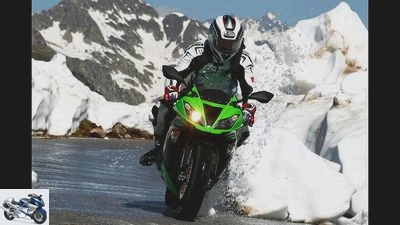
fact,
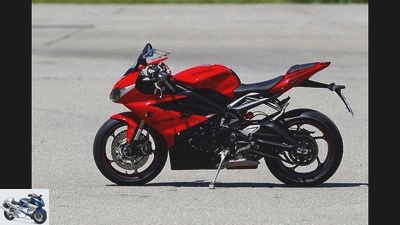
fact,
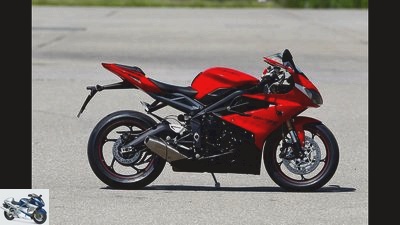
fact,
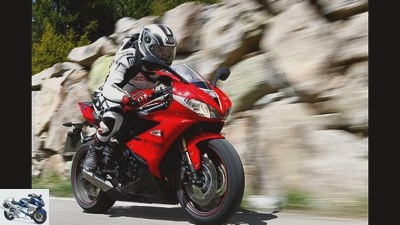
fact,
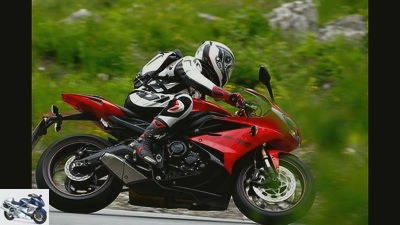
fact,
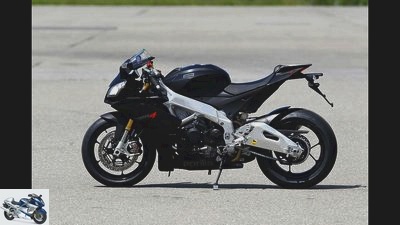
fact,

fact,
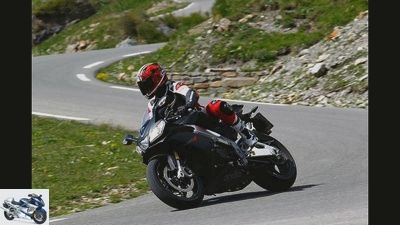
fact,
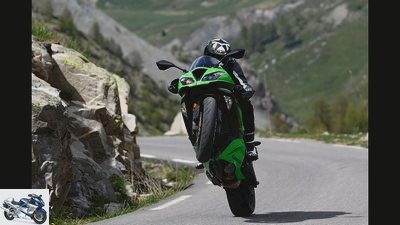
fact,
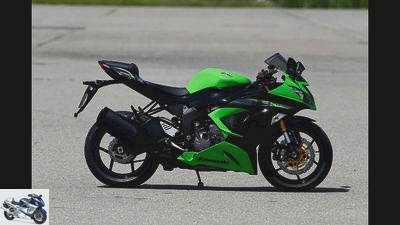
fact,

fact,
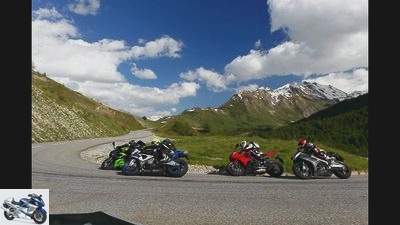
fact,
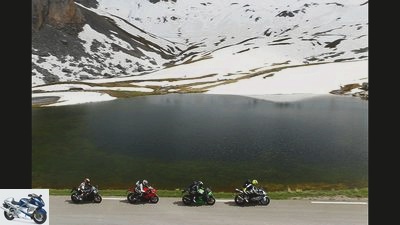
fact,
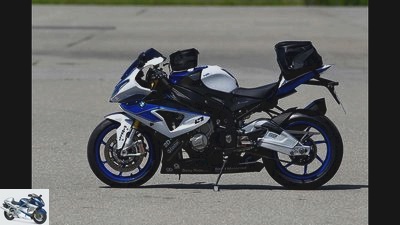
fact,
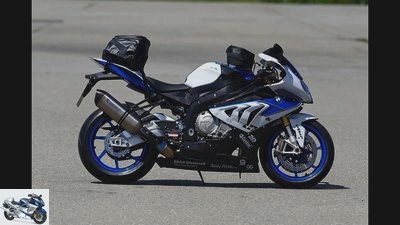
fact,
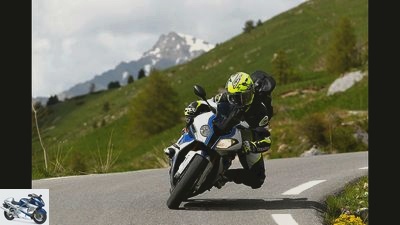
fact,
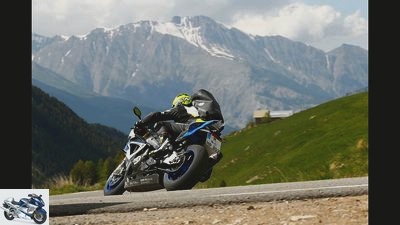
fact,
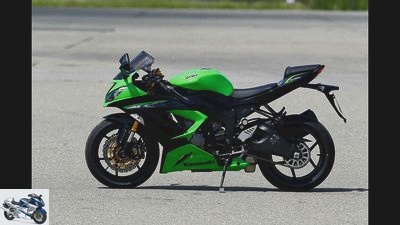
fact,
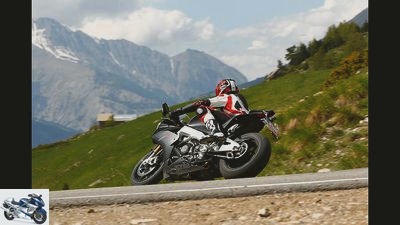
fact,
Leaving the world of reason to which athletes climb
Let’s just leave the world of reason for a few pages. Let’s not talk about luggage storage, main stand, pillion ergonomics or suspension comfort. Let’s not worry about how you can get from Germany to the Alpes-de-Haute-Provence with an uncompromising super sports bullet. Rather, let’s enjoy the unique driving fun that a modern super sports car offers on intertwined mountain passes or winding connecting stages, if you want to get involved.
So there are four of the best and most exciting athletes of 2013 at the foot of the Col de la Bonette, cutting-edge machines with the latest chassis and engine technology. Including BMW’s high-flyer HP4 and the Aprilia RSV4 R, which is now available with ABS, two powerhouses in the superbike category with a full liter displacement, which two handy super athletes in the – in the broader sense – 600 category have to fight off, namely the Kawasaki ZX-6R 636 and the Triumph Daytona 675. So also a competition of cubic capacities, all the more interesting in this special environment, since power and performance in the border area on undulating Alpine passes are certainly not the primary topic. And so, after days of testing and measuring, a result comes up that cheerfully mixes up the displacement classes. The fact that the Aprilia RSV4 R lands in fourth place is by no means a disgrace in this top-class field. And it’s further proof that power isn’t the key here. Because the Aprilia delivers more than enough of that. But unfortunately it only develops brute thrust in the upper half of the speed range.
Good for racing, bad for cruising on narrow, slippery Alpine serpentines, you would rather have predictable pressure in the basement. In combination with a miserably long first course, this creates stress. At first almost nothing works, then suddenly everything works when the V4 strikes with such vehemence that it almost pulls the handlebars out of the driver’s fingers. In between there is only a small amount of cooperative leeway that requires concentration and a lot of manual work to achieve.
BILLION
The performance of the tested athletes.
This permanent search for manageable performance is accompanied by an acoustic explosiveness that may make the neck hairs of some drivers, but is perceived from the outside more as a provocation. Such a roar seems out of place in echoing mountain canyons. It’s a shame, because the chassis of the Italo athlete is tuned to be sporty and tight, but spoils you with fantastic transparency and unearthly feedback on smooth terrain.
A similar classy racer is the Triumph Daytona 675: high seat, deep stub, a lot of pressure on the front wheel and on the wrists. Helpful on the racetrack, but tiring downhill at civil speed in the long run. In addition, there is a chassis set-up that is designed with a firm hindquarters for good traction when accelerating out on the slopes, not aimed at comfort on bumpy mountain passes. Every now and then the triumphant feels like a crosser who masters mogul slopes with wild leaps in the air.
Involuntary freestyle deposits with the Triumph Daytona
Anyone who overlooks these nasty transverse waves in the asphalt on the Bonette in the direction of Jausiers downhill, for example, can show off involuntary freestyle interludes with the Daytona. And has to hold the handlebars firmly in the grip despite the shock absorber. Okay, extreme situations. Down in the valley from Jausiers towards Larche you can let the three-cylinder off the leash on an ironed surface, there it inspires with linear, powerful characteristics, with incomparable handling and an equally unique sound. A great engine.
Simply enjoy the route with the athletes.
Nevertheless, the four-cylinder Kawa ZX-6R can surprisingly follow the triple in the switchback worm without permanently landing at the limiter. The 636 pulls forward from the very bottom with gentle pressure. If you don’t want to be on the last groove – and you should avoid that here as much as possible – you don’t need more gear changes than the Triumph driver. Only more open throttle valves and a tightening of the pace remind us that the new ZX-6R is basically a drilled out 600.
When it comes to handling, the Kawa doesn’t seem as jagged and direct as the Triumph, which is perceived as pleasant in the alpine environment. The Kawa is more good-natured and less borderline. This also applies to the much softer coordination of the suspension elements, which deal more humanely with the fresh frost breakouts in the part of the bonette that has just been cleared of snow. Of course, rough humps also push this chassis to its limits, in the end a super athlete simply runs out of spring travel there. Overall, an all-round convincing performance of the Kawa, the bottom line is that the distance to the group winners is limited, especially since important points are lost due to the meager equipment and insufficient payload.
With the BMW HP4, even leisurely twitching is fun
The victory of the BMW HP4 is a relatively clear matter. A noble athlete with an unbelievable range, as a racing replica on the slopes at breakneck speed – and still with well-mannered manners in everyday life. It is certainly not the tremendous peak performance that makes the pendulum swing in their favor.
The BMW wins the engine chapter thanks to its linear characteristics with a lot of pressure even in the middle speed range, thanks to the excellent throttle response and smoothness of the drive, thanks to precise shifting and variable engine mappings. The electronics are also helpful in other areas: the chassis and assistance systems can be changed in a flash while driving. And that with a noticeable effect. It may surprise some: With the BMW, even leisurely twitching is still fun, which means that victory in this category is ultimately undisputed.
Data and measured values
| Aprilia RSV4 R APRC ABS |
BMW HP4 |
Kawasaki ZX-6R 636 |
triumph Daytona 675 |
|
| engine |
Four-cylinder | Four-cylinder | Four-cylinder | Three-cylinder |
| Displacement |
1000cm³ | 999 cm³ | 636 cc | 675 cc |
| power |
184 hp | 193 hp | 131 hp | 128 hp |
| Torque |
117 Nm | 112 Nm | 71 Nm | 74 Nm |
| Weight |
209 kg | 203 kg | 196 kg | 193 kg |
| Payload |
197 kg | 205 kg | 178 kg | 186 kg |
| price |
€ 17,103 | € 20,500 | € 13,195 | 11890 € |
| Price test motorcycle |
€ 17,103 | 24 160 € * | € 13,195 | 11890 € |
| Test consumption passes |
6.4 l / 100 km / h | 5.4 l / 100 km / h | 4.8 l / 100 km / h | 4.7 l / 100 km / h |
| theoretical range passes |
291 km | 322 km | 355 km | 372 km |
| Passage in 2000 m above sea level, 50-100 km / h |
9.0 sec | 6.3 sec | 7.2 sec | 6.5 sec |
| Pulling uphill with pillion passenger, 2nd gear, 25-75 km / h |
9.3 sec | 5.5 sec | 6.3 sec | 6.3 sec |
| Braking distance downhill with pillion passenger, 75-25 km / h |
27.3 m | 26.3 m | 26.9 m | 28.4 m |
* including SA package Competition (3200 euros), pillion package (260 euros), heated grips (200 euros)
Alpen Masters ranking
| Maximum score |
Aprilia RSV4 R APRC ABS |
BMW HP4 |
Kawasaki ZX-6R 636 |
triumph Daytona 675 |
|
| engine | |||||
| Acceleration 0-140 km / h | 20th | 20th | 20th | 18th | 19th |
| Passage in 2000 m above sea level | 20th | 10 | 18th | 16 | 17th |
| Pulling through in 2nd gear uphill with a pillion passenger | 20th | 4th | 17th | 15th | 15th |
| Power delivery | 20th | 9 | 14th | 14th | 13 |
| Response / load change behavior | 20th | 12th | 15th | 15th | 14th |
| coupling | 20th | 12th | 15th | 17th | 14th |
| circuit | 20th | 15th | 18th | 16 | 14th |
| Gear ratio | 10 | 4th | 5 | 7th | 6th |
| total | 150 | 86 | 122 | 118 | 112 |
| Driving behavior | |||||
| Coordination / comfort | 20th | 9 | 12th | 13 | 9 |
| Suspension reserves when loading | 20th | 15th | 16 | 13 | 14th |
| Manageability on mountain passes | 20th | 12th | 11 | 16 | 14th |
| Stability in turns | 20th | 16 | 17th | 15th | 14th |
| Steering precision / feedback | 20th | 16 | 16 | 16 | 15th |
| Braking effect | 20th | 17th | 19th | 17th | 16 |
| Downhill braking / fading | 20th | 10 | 13 | 11 | 9 |
| SECTION | 15th | 12th | 14th | 12th | 12th |
| Traction control | 5 | 5 | 5 | 5 | 0 |
| Righting moment when braking | 10 | 6th | 6th | 6th | 6th |
| No inclination when loading | 10 | 10 | 10 | 10 | 10 |
| total | 180 | 128 | 139 | 134 | 119 |
| everyday life | |||||
| Furnishing | 20th | 8th | 12th | 8th | 9 |
| Luggage storage | 10 | 1 | 1 | 1 | 1 |
| Range passes | 20th | 11 | 13 | 16 | 17th |
| Payload | 20th | 11 | 13 | 7th | 9 |
| Loading handling | 10 | 6th | 6th | 6th | 6th |
| Front / rear view | 10 | 3 | 5 | 5 | 5 |
| Ground clearance with pillion passenger and luggage | 10 | 6th | 6th | 6th | 6th |
| total | 100 | 46 | 56 | 49 | 53 |
| Comfort | |||||
| Driver comfort | 20th | 8th | 9 | 10 | 7th |
| Seating comfort passenger | 20th | 1 | 2 | 3 | 2 |
| Wind and weather protection | 20th | 5 | 6th | 5 | 3 |
| Smooth running engine | 10 | 5 | 6th | 7th | 7th |
| total | 70 | 19th | 23 | 25th | 19th |
| Total |
500 |
279 |
340 |
326 |
303 |
| Placing group |
4th. |
1. |
2. |
3. |
Conclusion:
It was clear: athletes are uncomfortable, overpowered and nervous in the Alps. In other words: actually completely out of place. But somehow that’s what makes the challenge and fascination. And BMW’s power monster HP4 is also the hammer in this environment. But the same applies to all four: Why not something more civil, that is, quieter?
1st place: BMW HP4
The BMW HP4 was able to impress even on the alpine route.
plus
- Endless power
- clean throttle response
- semi-active chassis
- diverse setting options
- very good stability
- Brakes phenomenal
minus
- first course on passes long
- limited seating and driving comfort
- Motor running a bit rough
- Driving noise borderline
2nd place: Kawasaki ZX-6R 636
www.
The Kawa ZX-6R 636 made it into second place with a difference of 17 points.
plus
- decent draft
- smooth throttle response
- lowest clutch force
- excellent handling
- tolerable seating comfort
minus
- Poor payload
- Equipment not particularly extensive
- often starts with a delay
3rd place: Triumph Daytona 675
The Triumph Daytona 675 took third place.
plus
- wide performance range
- even strength development
- good driving performance
- good handling
minus
- Rear suspension stubborn
- Circuit a bit bony
- Equipment poor, no traction control
- uncomfortable sitting position
4th place: Aprilia RSV4 R APRC ABS
www.
The Aprilia RSV4 R APRC ABS came in last.
plus
- Suspension with excellent feedback
- Shift assistant
- good handling
minus
- extreme sitting position
- little suspension comfort
- inhomogeneous performance characteristics
- high consumption
- long translation
This is how MOTORRAD tests
Into the full: Before the test machines travel to the Alps in vans or axles, they have to show their colors on the test course. In the slalom and in the circular path, the limits of the bikes can be explored precisely and reproducibly.
Before the mountain festival:
Before the Alpen Masters entourage moves into the mountains, the measurements on the MOTORRAD test course provide interesting basic data. These findings help to assess the strengths and weaknesses of the machines in the Alps even more clearly.
Again and again, the main stand that touches down early disturbs the line of the Ducati Hyperstrada. Top tester Karsten Schwers and partner Rainer Froberg look exasperated at colleague Peter Mayer at the light barrier. He twisted the corners of his mouth. Little lean angle, moderate speed, bad lap times. The equation on the MOTORRAD test course is that simple. It took less than ten minutes for the Italian to show her colors in the forest of pylons on the former military airfield. The fact that the Duc made a positive impression with good acceleration values from zero to 140 km / h and that it rehabilitated itself in the slalom with agile steering behavior made the notch a little bit exposed when it appeared in the circular path. So be it.
Because the results obtained are valuable for the test results of the Alpine Masters. Whether handling quality, suspension settings, pillion comfort or lean angle with load – all of this can be determined in the run-up to the MOTORRAD mountain festival under laboratory conditions. Weaknesses in extreme situations – such as the Ducati’s very limited lean angle – can be quickly identified and explored with minimized risk.
BILLION
The data and measured values of all tested motorcycles from "Pre-test".
Supplemented by the measured values subsequently obtained in the high altitudes of the Alps, these measurements are not only reflected in the scoring, but also form a reliable basis for assessing the test machines in the mountains. Nevertheless: The knowledge gained on the steep ramps and narrow bends of the Alpine passes can only be supplemented, not replaced, even by the most sophisticated art course. Luckily.
Related articles
-
Comparative test of naked bikes 2013
fact 37 pictures fact 1/37 Aprilia Shiver 750 ABS, Triumph Street Triple 675, Suzuki GSR 750, Kawasaki Z800, Yamaha FZ8, MV Agusta Brutale 800 and BMW F …
-
www. 116 photos fact, 1/116 The extreme seating position was also not ideal for the test track. fact, 2/116…
-
Gargolov 45 photos 1/45 A flexible, high-torque engine is hidden in the Kawasaki Versys, but the Kawa cannot keep up with the BMW or the Ducati. The also…
-
Comparison test of superbikes, part 1: Country road
Jorg Kunstle 36 pictures 1/36 Comparison test Superbikes: Aprilia RSV4 RF, BMW S 1000 RR, Kawasaki ZX-10R, Yamaha YZF-R1M. 2/36 …
-
45 photos 1/45 A flexible, high-torque engine is hidden in the Kawasaki Versys, but the Kawa cannot keep up with the BMW or the Ducati. The…
-
Power Naked Bikes in Comparison – Part 2
31 photos 1/31 BMW S 1000 R, Honda CB 1000 R, Kawasaki Z 1000, Suzuki GSX S 1000 and Yamaha MT 10 in the comparison test….
-
The super sports mega test part 3: Nardo video
82 pictures Kuenstle 1/82 Easy to use traction control of the Aprilia. Kuenstle 2/82 A thoroughbred racing file with incredible …
-
BMW R 1200 GS model 2013 and 2012 in comparison
Jahn 26 pictures Jahn 1/26 The current change of regent on the BMW R 1200 GS is rightly the most technically incisive of the 33-year-olds …
-
Comparative test of the super sporty 600 series, part 2
Gargolov comparison test super sporty 600, part 2 roundabout last groove and full of gas ?? when comparing the racetrack there is for the …
-
Comparison test of superbikes part 2 – racetrack
51 pictures 1/51 The Kawa brake was transformed. She looked dull and lacked exact feedback. …